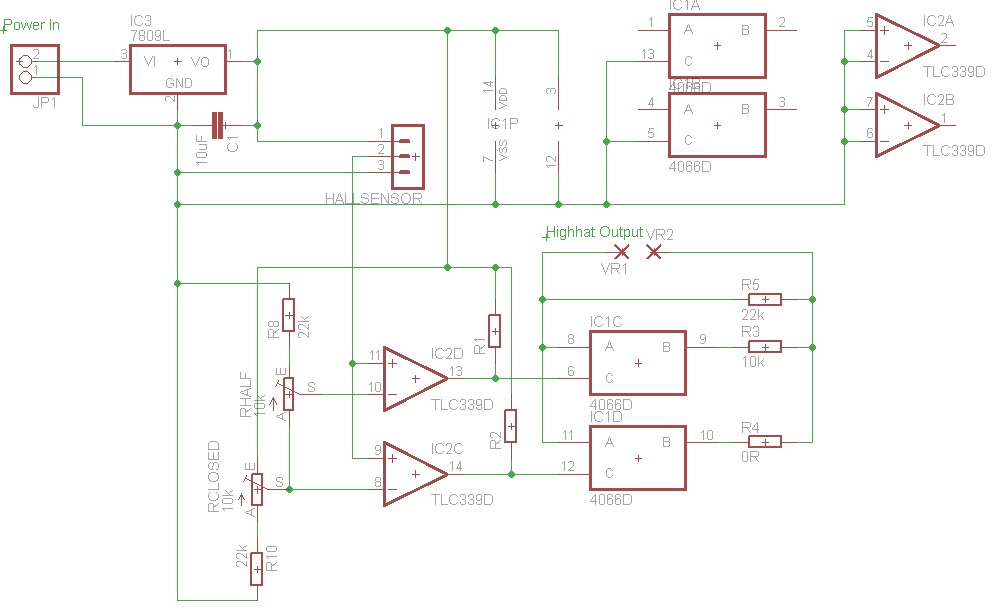Difference between revisions of "Hall-High-Hat-Hack-Schematic"
From Just in Time
| (7 intermediate revisions by the same user not shown) | |||
| Line 1: | Line 1: | ||
| − | R1 and R2 are pull-up resistors which were necessary because the used quad comparator had open-collector outputs. If you have a comparator with output resistors, you can leave them out. | + | R1 and R2 are pull-up resistors which were necessary because the used quad comparator had open-collector outputs. If you have a comparator with output resistors, you can leave them out. VR1 and VR2 go to the output jack, polarity is irrelevant. The Hall sensor is connected by a pin header for easier assembly. The middle pin of the header is the sensor output, pin 1 is +V and pin 3 is Ground of the sensor. R8 and R10 are intended to optimize the adjustment range of the sensitivity, but can also be left out if you use trimpots. Make sure to connect unused inputs of the leftover comparators and switches to ground or +V to avoid oscillations. Make sure the Hall Sensor you have works with the 9V power supply. If you have a Hall Sensor that needs a lower supply, the whole circuit should work on +5V just as well. Just use a 7805L in that case and make sure yer comparator IC works at 5V too. |
| + | |||
| + | I should add that the schematics and Eagle files presented here are corrected versions of the PCB I made (since there were two minor errors in the prototype) and as such not tested themselves, but they appear identical to my final prototype. | ||
| + | |||
| + | Since there are two more unused comparators and switches left, the concept could easily be extended to support more 'switch-points'. I preferred to keep it simple, as the TD-3 doesn't support more levels anyway.. | ||
[[File:HallHighHatHack_Schematic.jpg]] | [[File:HallHighHatHack_Schematic.jpg]] | ||
Latest revision as of 14:15, 10 February 2011
R1 and R2 are pull-up resistors which were necessary because the used quad comparator had open-collector outputs. If you have a comparator with output resistors, you can leave them out. VR1 and VR2 go to the output jack, polarity is irrelevant. The Hall sensor is connected by a pin header for easier assembly. The middle pin of the header is the sensor output, pin 1 is +V and pin 3 is Ground of the sensor. R8 and R10 are intended to optimize the adjustment range of the sensitivity, but can also be left out if you use trimpots. Make sure to connect unused inputs of the leftover comparators and switches to ground or +V to avoid oscillations. Make sure the Hall Sensor you have works with the 9V power supply. If you have a Hall Sensor that needs a lower supply, the whole circuit should work on +5V just as well. Just use a 7805L in that case and make sure yer comparator IC works at 5V too.
I should add that the schematics and Eagle files presented here are corrected versions of the PCB I made (since there were two minor errors in the prototype) and as such not tested themselves, but they appear identical to my final prototype.
Since there are two more unused comparators and switches left, the concept could easily be extended to support more 'switch-points'. I preferred to keep it simple, as the TD-3 doesn't support more levels anyway..
